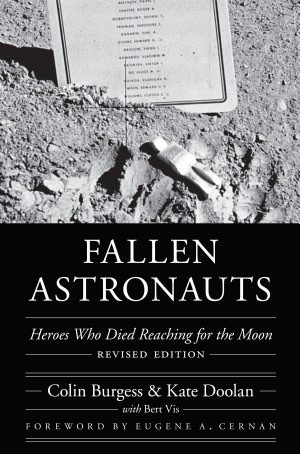Review: Fallen Astronautsby Jeff Foust
|
| The chapter on Soviet cosmonauts helps dispel some of the rumors about other deaths, notably Komarov’s on Soyuz 1. |
Most of those 14 men did not die on space missions. Vladimir Komarov died when his Soyuz 1 capsule crashed after the failure of its main parachute, while the three-man crew of Soyuz 11 died of asphyxiation when their cabin depressurized due to a leak after undocking from the Salyut 1 space station. Gus Grissom, Ed White, and Roger Chaffee died in Apollo 1, but that was during a ground test weeks before their scheduled launch. The rest, though, were claimed by aircraft accidents (including Yuri Gagarin, the first to fly in space), illness, and a car crash.
The chapters are based on incidents, so the Apollo 1 astronauts are grouped together in one chapter, as well as Charles Bassett and Elliot See, who were killed in the same T-38 crash. All the Russian cosmonauts are grouped together in one chapter, which also includes some cosmonauts who died in the 1960s but were not included in the plaque. One example is Grigori Nelyubov, drummed out of the cosmonaut corps in 1963 after a run-in with a military security patrol; he died in 1966 when he fell, or jumped, in front of a train. The Soviet Union didn’t acknowledge he was a cosmonaut until 1986.
That chapter on Soviet cosmonauts helps dispel some of the rumors about other deaths, notably Komarov’s. It’s highly unlikely, the authors argue, that his wife bid him “an emotional, tearful farewell” from mission control prior to the Soyuz’s reentry, as mission control was in Crimea, was far from his wife’s Moscow home. It’s also not credible that Komarov cursed the Soviet government over the radio during the capsule’s freefall, as there was no radio contact with the capsule during its descent.
Much of the rest of Fallen Astronauts is a familiar examination of the lives of astronauts, some of whom died for mundane reasons in their pursuit of the Moon. The authors, for example, are critical of the decision to exclude Ed Givens, who died when his car went off a rain-slicked road one night, from an astronaut memorial because he was not yet assigned to a mission. Givens is recognized, though, both in this book and in that memorial placed on the Moon by Scott and Irwin 45 years ago.
